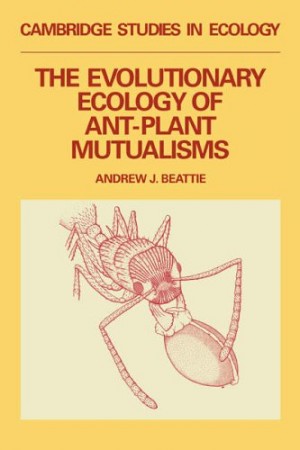The Evolutionary Ecology of Ant–Plant Mutualisms

| Auteurs |
|
| Éditeurs |
|
| Parution | 29/10/1985 |
| Pages | 277 |
| Catégorie |
|
| Langue |
|
Présentation
Mutualistic interactions between ants and plants involve rewards offered by plants and services performed by ants in a mutually advantageous relationship. The rewards are principally food and/or nest sites, and ants in turn perform a number of services for plants: They disperse and plant seeds; they protect foliage, buds, and reproductive structures from enemies such as herbivores and seed predators; they fertilize plants with essential nutrients; and they may sometimes function as pollinators. In this book Professor Beattie reviews the fascinating natural history of ant-plant interactions, discusses the scientific evidence for the mutualistic nature of these relationships, and reaches some conclusions about the ecological and evolutionary processes that mold them. Mutualisms involving single pairs of species are the exception rather than the rule; usually arrays of ant species interact with arrays of plant species. Variation generated by this complexity results in variation in the function and the effectiveness of the mutualism. The result is that at any given time and place some or all of the interacting species may experience full, intermediate, or episodic benefits, or no benefits at all. This highly dynamic picture is unlikely to be confined to ant-plant mutualisms, but rather may be representative of a host of other kinds of species interactions. This important work is the first broad and thorough treatment of the subject of ant-plant mutualisms. Its natural history, experimental approach, and integration with contemporary evolutionary and ecological literature will appeal to a wide variety of biologists.
Sommaire
- 1Introduction
- 8Origins and early evolution of ant-plant mutualisms
- 8Ants and plants in the Cretaceous
- 11The impact of the ant's mode of feeding
- 15The impact of social organization
- 19Early ant-plant habitats
- 21Plant protection by direct interaction
- 27Ant nests and domatia
- 34Food bodies
- 37Extrafloral nectaries
- 50A closer look at ant guards and extrafloral nectaries
- 54Plant protection by indirect interaction
- 54Homopterans
- 61Lepidopterans
- 63Summary and conclusions
- 66Myrmecotrophy
- 73The dispersal of seeds and fruits by ants
- 73The predator-avoidance hypothesis
- 75The competition-avoidance hypothesis
- 76The fire-avoidance hypothesis
- 77The dispersal-for-distance hypothesis
- 77The nutrient hypothesis
- 78Assessment of the hypotheses
- 87The distribution and variability of ant dispersal
- 90The ants that disperse seeds
- 96Ant pollination
- 110Food rewards for ant mutualists
- 110Ant nutrition
- 113Elaiosomes
- 115Extrafloral nectar
- 118Food bodies
- 119Rewards offered by homopterans and lycaenid larvae
- 120Ant rewards: supply and demand
- 128Variation and evolution of ant-plant mutualisms
- 130Generalist versus specialist
- 131Selection and fitness
- 138Pathways to mutualistic interaction and coevolution
- 146References
- 177Index
- 5 lectures
Bibliothèque
